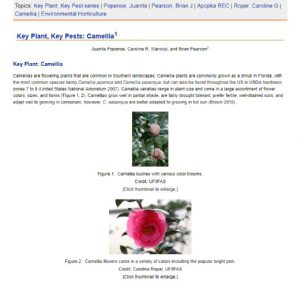Key plants are common plant species grown in Florida landscapes that are frequently infested with specific pests or diseases at specific times of the year. The concept of key plant/key pests is simple but requires knowledge.
- Some plants have many pests and some plants have few.
- Often such key plants have specialized pests, are more preferred cultivars or are plants that are not adapted to the location and site conditions.
- Knowing the key pests associated with the plants can greatly aid in scouting, identification and management.
 On the UF/IFAS Extension EDIS website, there is a series of Key Plant, Key Pests publications designed for Florida gardeners, horticulturalists, and landscape professionals to help identify common pests associated with common Florida flora. For instance, crapemyrtles are known for being one of the most pest-free landscape plants. The key plant/key pests publication provides information and general management recommendations for the crapemyrtle aphid, metallic beetles, and powdery mildew. Another publication on camellias helps to identify its most common pests and includes information and general management recommendations for algal leaf spot, dieback, twig blight or canker, flower blight, wet root rot diseases, root rots, aphids, scale, spider mites, and nutrient deficiencies.
On the UF/IFAS Extension EDIS website, there is a series of Key Plant, Key Pests publications designed for Florida gardeners, horticulturalists, and landscape professionals to help identify common pests associated with common Florida flora. For instance, crapemyrtles are known for being one of the most pest-free landscape plants. The key plant/key pests publication provides information and general management recommendations for the crapemyrtle aphid, metallic beetles, and powdery mildew. Another publication on camellias helps to identify its most common pests and includes information and general management recommendations for algal leaf spot, dieback, twig blight or canker, flower blight, wet root rot diseases, root rots, aphids, scale, spider mites, and nutrient deficiencies.
You can view the key plant/key pest publications currently available here.
 1
1
